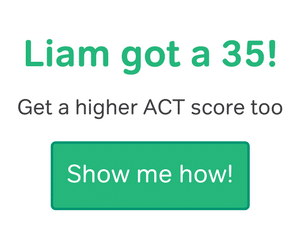While the ACT Math section just before it is like a marathon of numbers, the ACT Reading section is like a mad dash through word town. You only have 35 minutes to read four ACT Reading passages, each about 100 lines in length, and answer 40 questions. That’s 8 minutes and 45 seconds per passage. It’s stressful. It’s tricky. And it’s common to run out of time.

If you find yourself scrambling before the finish line, channel your inner Super Mario and follow these tips to get as many points as you can before time runs out.
1. Figure out what order to read the passages BEFORE you take the test.
The ACT Reading passages is divided into four genres: literary narrative, social sciences, humanities, and natural sciences. The ACT will always present the passages in that order, so you should have a game plan before you start the reading section. If you like reading articles about how artists get inspired or how music influenced culture, start with the humanities. If you like scientific explanations behind the mysteries of space or why fish have electric sensors, start with natural sciences.
If you aren’t sure what order you should take it, or even if you think it doesn’t matter what order you take it, try this: time yourself the next time you take a practice ACT Reading section. Start the clock when you begin reading a passage, mark the time when you’ve finished reading the passage, and stop it when you finished answering the questions. You may surprise yourself with how you spend your time. Next time, start reading the passages that take you the least time to complete and save the passages that take up more time for last.
2. Go for the low hanging fruit.
The less you have to go back and reread the passage, the more time you save. One way to do this is to read through all the answer choices before going back to the text. Odds are good that you can eliminate one or two (sometimes three) wrong answer choices using your memory alone.
In terms of specific ACT Reading question types, you should start with the ones that specifically reference certain lines or paragraphs. After you’ve eliminated wrong answer choices based on your memory, go back to the text and see if you can find the best answer. Since you’ve read all the answer choices and eliminated some of them, you know what you should be looking for. These questions tend to be easiest to answer, but be sure to read a little before and a little after to get the full context of the line. After that, you can answer the rest of the questions as they come.
However, save any question that has NOT in all capital letters until the end of the passage. For example: “Which of the following is NOT a claim the author makes?” The question provides you with three correct statements and one incorrect statement, and you have to pick the incorrect one. These questions are often super detail-focused, so you will need to flip back and forth between the answer choices and the passage, checking off which of the four answer choices is supported by the passage. These questions take up the most time, so save them for the end.
3. Don’t get too invested in your passage.
So I was reading a sample prose passage about a violinist rehearsing one of Mozart’s concertos. I play violin, so I was thinking in my head, “OH YEAH I’VE BEEN THERE” or “YOU HAVE NO IDEA WHAT YOU’RE TALKING ABOUT, YOU MA’AM ARE LYING.” I was really invested in the passage, and you know what happened? I spent 1 more minute reading than I needed to because I got distracted by my thoughts.
Time is precious with the ACT Reading, so think of yourself as a robot: you have no opinions or outside knowledge beyond what is fed to you in the passage. If the passage talks about the the author’s support of Donald Trump for president, resist the urge to disagree with the author. You only care about the examples, arguments, and logic contained within the passage. For example, if a question asks you, “What was the result of Donald Trump hosting Saturday Night Live during his campaign?”, do not rely on your own knowledge of how terrible an episode it was. Focus strictly on what the text gives you. The more you keep this distance between you and the passage, the quicker you will be able to read through it and the more time you have to blaze through the reading section.
4. Save the double passage for last.
The past few ACTs have featured double passages. Instead of reading a single passage about 100 lines long, you will read two passages about 50-60 lines each. Once you’re familiar with the format though, you’ll see why we save them for last.
The first thing you should do is read the first of the two passages. Once you’ve finished reading passage one, skip down to the questions and start answering the questions that ONLY deal with passage one. They are clustered at the beginning of the passage’s questions. When you start seeing questions that deal with passage two, go back and begin reading the second passage. When you’ve finished reading passage two, hop back down to the questions and begin answering all the questions that deal specifically with passage two. The last 3-4 questions of the double reading passage will ask you to compare and contrast different aspects of passages one and two. Since you’ve already answered several questions about each individual passage, you should be able to answer most of these based on your memory alone.
If you’re saving this passage for last, that means you probably only have a few minutes left on the clock. If time is called in the middle of you reading passage two, it’s not the worst thing in the world since you’ll at least have 3 or 4 questions answered on your sheet that dealt with passage one. It’d be worse if time was called in the middle of reading a long passage and you had zero questions answered.
Look to Mario as a role model for dealing with the ACT Reading section. When he goes to the bonus room at the beginning of the stage, he racks up a lot of coins early on without wasting a lot of time. As a test taker, you want to do the same thing: rack up as many correct answers as you can without wasting a lot of time. Each of these strategies is devoted to minimizing the amount of time you need to answer correct questions. You may not be able to get through the entire reading test before time is called, but you can take comfort in the fact that you’ve got 30+ answers down on your answer sheet that you feel confident in.






Leave a Reply